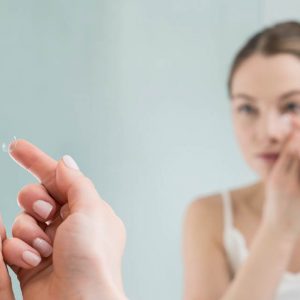Soft contact lenses come in hydrogel or silicone hydrogel materials – but which is best for you?
The most common types of contact lenses are hydrogel and silicone hydrogel – these are known as soft contact lenses.
Both hydrogel and silicone hydrogel lenses are made of a soft water-based plastic material. When hydrated with water or lens solution, the material absorbs moisture and softens the lens and when dry, it hardens.
Hydrogel contact lenses
Soft contact lenses using hydrogel were first available in the 1980s.
Hydrogel lenses are made from hydrogels, which are gel-like, water-containing polymers. These lenses are extremely thin and malleable, and they adhere to the eye’s surface.
The majority of soft lenses, including disposable lenses, are made from hydrogel.
Due to their improved comfort and ease of use, hydrogel lenses have made disposable contacts the first choice for both eye doctors and their patients.
When it comes to dry and sensitive eyes, hydrogel material is frequently the best option due to its particular biocompatibility with the human eye.
When the water in hydrogel lenses gradually evaporates, for example, after many hours of wear or in dry or windy air, the material becomes drier and less comfortable to wear.
When lenses dry out, they allow less oxygen to reach the cornea, for this reason silicone hydrogel lenses were introduced.
Contact an eye doctor near you to learn more which type of material will best suit your eyes.
SEE RELATED: A Guide to Contact Lens Solutions
Silicone hydrogel contact lenses
In the early 2000’s, the first silicone hydrogel contact lenses were made available to patients.
This new material used silicone in a contact lens to allow more oxygen to flow to the cornea, increasing the comfort and clinical performance over hydrogel lenses.
Silicone hydrogel lenses are a more porous type of soft contact lens than regular hydrogel lenses, allowing more oxygen to enter the cornea. It’s a hybrid of hydrogel and silicone that boosts the oxygen permeability of the lenses.
This feature makes them an excellent choice for long-term use.
The drawback of silicone hydrogel lenses is their tendency for the lens to collect more debris and protein deposits from your tears.
Which is better for you?
There isn’t such a thing as a one-size-fits-all contact lens, it’s a matter of determining which option is best for your eyes.
In tests, neither material outperformed the other in terms of comfort, and both had a low incidence of contact lens related problems and complications.
The most important distinction between these lenses is your vision, comfort and oxygen flow to the cornea.
Your eye doctor will examine your eyes and provide a comprehensive contact lens exam to determine which is best for your individual needs.
LEARN MORE: Optical and Contact Lenses
Contact an eye doctor near you to discuss which lenses will best suit your needs.
The most common types of contact lenses are hydrogel and silicone hydrogel, known as soft contact lenses.
Together with your eye doctor, you can learn the benefits of each and determine which is the best choice for you.










